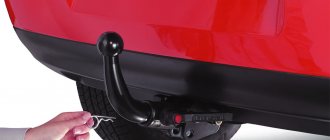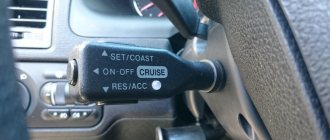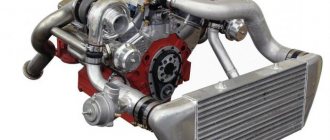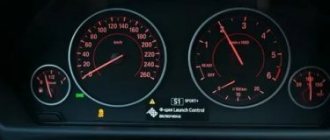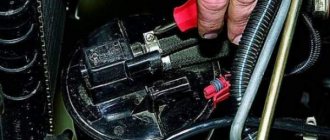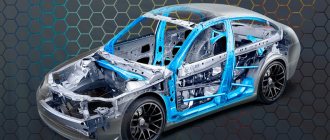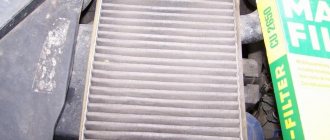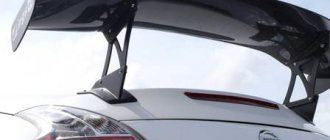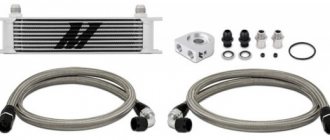The term plastics describes a group of chemical compounds called polymers. Plastic is made by heating hydrocarbons. A catalyst is used to break large molecules into small ones. This process is called cracking. Small molecules such as ethylene, propylene, butane and others are called monomers. Most plastics are made from hydrocarbons taken from natural resources (gas, oil and others). The chemical combination of monomers and the creation of polymers is carried out. The size and structure of polymer molecules determine the properties of plastics. There are two basic types of plastic that are used in the automotive industry - thermoplastics and thermoset plastics. Thermoplastics melt when exposed to high temperatures, and when cooled they harden again. Thermosetting plastics never melt or soften due to temperature (do not change shape).
One of the first bumpers
Cars of the early twentieth century had wheels pushed forward, so bumpers helped protect the chassis from impact, although at low speeds - up to 5 km/h.
The first bumper appeared on the 1927 Ford Model A, it was available as a standard option. It consisted of two thin plates that were attached to brackets to the car frame. He could soften a small blow, after which, under the mechanical influence of a person, he returned to his shape.
Ford Model A (1927)
After that there was a whole era of iron bumpers, which was called “the best time in car design.”
Car bumper: what is it, types, where is it located, what is it needed for
A bumper is an energy-absorbing element of a car, presented in the form of a bar, located in the front and rear, which is a type of buffer. The term comes from the English word bumper. The part itself is of particular importance; it allows you to protect the car and important elements of the car from damage due to minor impacts . Here you only have to provide repairs to the bumper, without unnecessary costs for servicing other modules.
Bumpers in tuned cars are chosen so that they have a harmonious appearance and frame the visible parts of the car. Still, the car should be different from others, that’s why tuning exists.
In the article I will tell you in detail what it is - a car bumper, the history of its creation, types, structure and what they are made of, as well as advantages and disadvantages.
First plastic bumper
The first plastic bumpers familiar to us appeared in Europe in 1976, on Simca 1308 cars. They were of a contrasting color to the body.
After this company, all European manufacturers picked up the idea and began making just such bumpers.
The first plastic bumper on the Simca 1308
Over time, the requirements for them have grown; now they must be safe not only for cars, but also for pedestrians. At low speeds, no more than 8 km/h, they should not cause serious harm to health, as the old, iron ones did.
What should a car owner do if the bumper is damaged?
What should a car owner do if the bumper is damaged?
Of course, the first thing that comes to mind is to buy a new bumper. When the bumper is very badly damaged, this is the easiest way out of this situation. If the bumper has only minor cracks or scratches, then you can simply repair the plastic bumper at a car repair shop or do it yourself. After all, buying a new bumper is a very expensive pleasure and it is unlikely that every motorist will be able to afford it.
But besides everything else, before purchasing this car part, repair has many advantages:
- This is many times cheaper than purchasing a new bumper;
- This is faster, because often a new bumper needs to be ordered and this can take almost a week, and repairs take from two hours to two days.
– we cannot exclude the fact that when ordering a new bumper from a dubious company, you can get a fake or previously restored bumper at the price of a new one.
Repair of a plastic bumper can be carried out both locally and comprehensively. During local repairs, the damaged part is restored without the need to remove it from the car. But an integrated approach, on the contrary, involves dismantling the bumper, and after completing the repair work, installing it in its original place.
Material for making bumpers
There are three main types:
- thermosetting fiberglass - an irreversible reaction occurs during manufacturing, after which it can be welded, dissolved or stretched;
- thermoplastic plastic is a type of plastic that consists of separate branched macromolecules that are not interconnected;
- mixtures of plastics - for example, “PP + EPDM”.
All types of plastic that are used in production have their own designation.
PC - polycarbonate (thermoplastic)
It is resistant to shock loads, even in sub-zero temperatures.
Used to make headlights, dashboards, bumpers and radiators for civilian vehicles.
PP and PP/EPDM - regular polypropylene and ethylene diene
PP (thermoplastic) is moderately flexible, resistant to chemicals, and also has good UV resistance.
EPDM (thermoset) – additive to PP.
It is these two components that most automakers use in production.
GRP/SMC - fiberglass (mixture)
Fiberglass is a very light and yet durable material that is not inferior to steel in strength, but is 4 times lighter. The material is used on racing cars; It is extremely rare on civilian cars due to the high price.
Modern manufacturers make bumpers mainly from ethylene diene (PP/EPDM) using various additives so that the part is not destroyed by external natural factors.
Some manufacturers use fiberglass reinforced plastic (GRP) to make the part as strong as possible while being lightweight. It cannot be found on civilian cars in the mass segment; it is used for racing cars and special limited edition models. The body of the Ferrari F40 is entirely made of this material. “Civilian car” was the nickname given to this car, which weighed only 1200 kg, which was incredible in the 80s. That's why she was the fastest in her time. 1,315 copies were produced, although only 415 were planned.
Pros and cons of bumpers
The bumper is easily repairable and can be restored using heat and tool treatment. Each of the elements, depending on the material, has individual advantages and disadvantages. Thus, plastic structures are inexpensive, but difficult to restore. After repair, their protective properties decrease.
Silicone bumpers are endowed with certain ergonomic indicators, their rigidity is increased and the components are easy to repair. Plastic cracks very often. Therefore, when visually comparing the physical properties of individual materials with the prospect of long-term use, it is silicone that wins.
Metal buffers have increased reliability; most often these parts, together with massive amplifiers, are installed on expensive all-wheel drive vehicles. They are also chosen by fans of fast driving in extreme conditions. In other cases, bulky structures are considered a relic of the past, considering them unreasonably heavy for installation on a passenger car.
It is impossible to single out a specific advantage or disadvantage of the bumper as a separate structure. As a minus of the buffer, one can determine the increase in the weight of the vehicle and, accordingly, the increase in fuel consumption. This is only a relative disadvantage, manifesting itself as the only factor along with the advantages.
How to determine the type of plastic
To find out what your bumper is made of, just look at the back of it - there is a designation there.
This photo shows thermoplastic rubber, which has the following properties:
- elasticity when heated - such a part can be soldered and returned to its original appearance if cracks appear, for example, due to an impact;
- light weight - approximately 10 kg;
- resistance to low and high temperatures, from -35 to +140 degrees Celsius - in this range it does not lose its properties.
This is the most popular type of plastic - 90% of bumpers are made from this material or from a material with similar properties.
Types of automotive plastics
Modern cars include about 120 kilograms of parts made from various types of plastic.
The term plastics describes a group of chemical compounds called polymers. Plastic is made by heating hydrocarbons. A catalyst is used to break large molecules into small ones. This process is called cracking. Small molecules such as ethylene, propylene, butane and others are called monomers. Most plastics are made from hydrocarbons taken from natural resources (gas, oil and others). The chemical combination of monomers and the creation of polymers is carried out. The size and structure of polymer molecules determine the properties of plastics. There are two basic types of plastic that are used in the automotive industry - thermoplastics and thermoset plastics. Thermoplastics melt when exposed to high temperatures, and when cooled they harden again. Thermosetting plastics never melt or soften due to temperature (do not change shape).
Manufacturing
To make a bumper, a special device is used - an injection molding machine.
The machine melts plastic under high pressure. To obtain a quality product, the manufacturer must perform the following steps:
- Mix special granules in the required proportion according to the recipe. The raw materials include: polypropylene, rubber, light and temperature stabilizers and other additives, often kept secret.
- Before the granules enter the injection molding machine, they are dried to avoid defects.
- After drying, they enter the machine, where they are heated to high temperatures and turn into a liquid state.
- The liquid mixture enters the mold where it hardens.
- The bumper is ready, now it can be painted and installed on the car.
The output is a product with the properties desired by the consumer:
- strength;
- UV resistance;
- resistance to temperature changes;
- durability.
If the product passes all these tests, then the batch is allowed to be released and the part is installed on a new car.
Watch the video to see how car bumpers are made:
Plastics to the masses
In the 20th century, humanity experienced a synthetic revolution, new materials appeared in its life - plastics. Plastic can easily be considered one of the main discoveries of mankind. Without the invention of this material, many other discoveries would not have been possible or would have been achieved much later.
Alexander Parks. Inventor of plastics
The first plastic was invented in 1855 by British metallurgist and inventor Alexander Parkes. When he decided to find a cheap substitute for the expensive ivory from which billiard balls were made at that time, he could not even imagine what an important discovery he had made.
The ingredients of the first plastic were nitrocellulose, alcohol and camphor. The mixture of these components was heated to a fluid state, and then poured into a mold and hardened at normal temperature. This is how the ancestor of modern plastics, parkesin, was invented.
The development of plastics from natural materials to completely synthetic ones came later - when the German professor at the University of Freiburg, Hermann Staudinger, discovered the macromolecule - the “brick” from which all synthetic organic materials, and natural ones too, are built. This discovery brought Professor Staudinger the Nobel Prize in 1953.
From then on it all began... Almost every year chemical laboratories began to report the discovery of another synthetic material with previously unprecedented properties, and today the world annually produces millions of tons of all kinds of plastics, without which the life of a modern person cannot be imagined.
Plastics are used wherever possible: in ensuring a comfortable life for people, in agriculture, in all areas of industry. The automotive industry was no exception. Here, plastic is being used more and more widely, rapidly displacing metal from the position of its main technological competitor.
Compared to metals, plastics are very young materials. Their history does not even go back 200 years, while iron, tin and lead were familiar to man in ancient times - 3000-4000 BC. e. But despite this, plastic is in many ways superior to metal.
Specialized or “custom” bumpers
If you are bored with the appearance of your car, then there are companies that make bumpers and body kits for almost all cars.
Prices depend solely on the car and complexity - a part can cost from 8,000 to 150,000 rubles and more.
The largest tuning studios:
- Rieger Tuning – covers most European and German cars, such as: Skoda, Ford, Peugeot, Volkswagen;
- Kerscher Tuning – provides bumpers and body kits for almost all German cars, with the exception of Mercedes, which owns its own “court” tuning studio;
- Auto Couture is a Japanese company that produces bumpers not only for the domestic but also for the foreign market. It differs in that it makes body kits for expensive cars (Audi, BMW 7 Series and Maserati Quattroporte).
There are actually a huge number of tuning studios, so you can be sure that you can find a unique body kit for any car.
Bumper Crack Repair
Most often, the material does not rupture. In such cases, after the impact we can observe a crack. It seems like you can drive, but no! The insidiousness of such damage lies in the fact that literally after 100 km they can spread over the entire area of the bumper, and then prepare money for a new part. It is not always possible to repair them in the usual way, since they tend to self-expand. Therefore, it makes sense to protect yourself from this by fastening its “shores” with the staples of a construction stapler.
As with any operation, you also need to find out what type of plastic the material of your bumper is. If it is soft and pliable, then you can sew the crack directly with a stapler; if the bumper is fragile, then this method can lead to its irretrievable loss. We need to look for other ways...
First of all, all rays of the crack are carefully drilled. Only then do they begin the stitching procedure. In situations where it is impossible to use a stapler, you need to get: a soldering iron, stapler staples and a thin drill. It is with the help of the last device that the holes for the brackets are prepared.
The staples are carefully placed in the places prepared for them, and then heated with a soldering iron, thereby sinking them into the material. If there is no drill, then the staples themselves are heated and then welded into the plastic.
Next, you need to degrease the repair area and seal it with fiberglass cloth and putty. The area is locally sanded to match the surrounding details (this stage directly determines whether your friends will notice the defect or not), and then painted.
Why paint plastic?
The need to paint plastics is dictated, on the one hand, by aesthetic considerations, and on the other, by the need to protect the plastics. After all, nothing is eternal. Although plastic does not rot, during operation and atmospheric influences it is still subject to aging and destruction. And the applied paint layer protects the surface of the plastic from various aggressive influences and extends its service life.
At the factory, painting plastic parts does not cause any difficulties. The technologies here are well-established, and in this case we are talking about painting new identical parts from the same plastic. But in a workshop, painters are already faced with the problem of heterogeneity in the materials of various parts.
This is where you have to answer the question: “What is plastic anyway? What is it made from, what are its properties and main types?
Polymer designations
In the technical literature, international abbreviations for polymer designations are often found. If you do not know how to understand them and recognize plastics by their designations, this can lead to difficulties in working with materials. To avoid difficulties, you need to use a specialized reference book in which you can easily find not only the designation of polymers, but also various materials based on them.
Decoding of international designations of polymers and copolymers
| A | |
| ABA | Copolymer of acrylonitrile, butadiene and acrylate |
| ABS | Copolymer of acrylonitrile, butadiene and styrene (ABS copolymer) |
| ACETAL | Polyformaldehyde, formaldehyde copolymers |
| ACS | Copolymer of acrylonitrile, chlorinated polyethylene and styrene |
| A/EPDM/S | Copolymer of acrylonitrile, ethylene, propylene, diene and styrene (copolymer of acrylonitrile, EPDM and styrene) |
| AES | Copolymer of acrylonitrile, ethylene, propylene, diene and styrene (copolymer of acrylonitrile, EPDM and styrene) |
| A/MMA | Copolymer of acrylonitrile and methyl methacrylate |
| APAO | Amorphous poly-alpha-olefin |
| APET | Amorphous polyethylene terephthalate (copolymer) |
| AS | Acrylonitrile styrene copolymer (SAN) |
| A.S.A. | Copolymer of acrylic ester, styrene and acrylonitrile |
| ASR | Impact-resistant styrene copolymer (advanced styrene resine) |
| B | |
| BUTYRATE | Cellulose acetobutyrate, cellulose acetobutyrate etrol |
| C | |
| C.A. | Cellulose acetate, cellulose acetate etrol |
| CAB | Cellulose acetobutyrate, cellulose acetobutyrate etrol |
| CAP | Cellulose acetopropionate, cellulose acetopropionate etrol |
| CARBON | Material containing carbon fiber (CFRP) |
| C.E. | 1) Cellulose 2) Chlorinated polyethylene |
| CF | Cresol-formaldehyde resin |
| CN | Nitrocellulose |
| COC | Cycloolefin copolymer |
| compounded TPO | Thermoplastic polyolefin elastomer |
| CoPA | Copolyamide |
| COPOLYE | Copolyester |
| C.P. | Cellulose acetopropionate, cellulose acetopropionate etrol |
| CPE | Chlorinated polyethylene |
| CPVC | Chlorinated polyvinyl chloride |
| CR | Chloroprene rubber |
| Сrystal PS | General purpose polystyrene (transparent, undyed grades) |
| c-TPO | Thermoplastic polyolefin elastomer |
| CTPO | Thermoplastic polyolefin elastomer |
| D | |
| DAP | Polydiallyl phthalate |
| E | |
| EAA | Copolymer of ethylene and acrylic acid |
| EBA | Ethylene-butyl acrylate copolymer |
| E/BA | 1) Copolymer of ethylene and butyl acrylate; |
| E/BA | 2) ethylene blockamide |
| EBAC | Ethylene-butyl acrylate copolymer |
| E.C. | Ethylcellulose |
| E/CTFE | Copolymer of ethylene and trifluorochloroethylene |
| ECTFE | Copolymer of ethylene and trifluorochloroethylene |
| E/EA | Copolymer of ethylene and ethyl acrylate |
| EEA | Copolymer of ethylene and ethyl acrylate |
| EMA | Copolymer of ethylene and methyl acrylate |
| EMAA | Copolymer of ethylene and methacrylic acid |
| EMAC | Copolymer of ethylene and methyl acrylate |
| EMI | EMI shielding materials |
| EMMA | Copolymer of ethylene and methyl methacrylic acid |
| EMPP | Rubber modified polypropylene |
| EnBA | Ethylene-butyl acrylate copolymer |
| E.P. | Epoxy resin |
| EPDM | Ethylene-propylene-diene terpolymer (EPDM) |
| EPE | Foaming polyethylene |
| EPP | Expandable polypropylene |
| EPS | Expandable polystyrene |
| ESI | Ethylene-styrene interpolymer |
| E/TFE | Copolymer of ethylene and tetrafluoroethylene |
| ETFE | Copolymer of ethylene and tetrafluoroethylene |
| ETP | Thermoplastics for engineering and technical purposes, structural thermoplastics |
| E/VA | Ethylene-vinyl acetate copolymer (EVAC) |
| EVA | Ethylene-vinyl acetate copolymer (EVAC) |
| EVAC | Ethylene-vinyl acetate copolymer (EVAC) |
| E/VAL | Ethylene-vinyl alcohol copolymer |
| EVAL | Ethylene-vinyl alcohol copolymer |
| EVOH | Ethylene-vinyl alcohol copolymer |
| F | |
| FEP | Copolymer of tetrafluoroethylene and hexafluoropropylene, fluoroplastic 4MB |
| Fluorinated TPE | Fluoroplastic thermoplastic elastomer |
| FRP | Fiber filled polymer |
| FPVC | Plasticized polyvinyl chloride |
| G | |
| GPS | General purpose polystyrene |
| H | |
| HDPE | High density polyethylene (low density polyethylene) |
| HIPP | Highly isotactic polypropylene (homopolymer) |
| HIPS | Impact resistant polystyrene |
| HMW-HDPE | High molecular weight polyethylene |
| HMWHDPE | High molecular weight polyethylene |
| HMWPE | High molecular weight polyethylene |
| HMW-PE | High molecular weight polyethylene |
| HMW PVC | High molecular weight polyvinyl chloride |
| I | |
| I | Ionomer |
| In | Ionomer |
| in-reactor TPO | "Reactor" thermoplastic polyolefin elastomers |
| IONOMER | Ionomer |
| IPS | Medium impact polystyrene |
| IR | Isoprene rubber |
| Interpolymer | Interpolymer |
| L | |
| LCP | Liquid crystal polymer |
| LDPE | Low density polyethylene (high density polyethylene) |
| LFRT | Thermoplastic material filled with long fiber (glass fiber, etc.) |
| LLDPE | Linear Low Density Polyethylene |
| LMDPE | Linear medium density polyethylene |
| LSR | Liquid silicone rubber |
| M | |
| M-ABS | Copolymer of methyl methacrylate, acrylonitrile, butadiene and styrene (transparent ABS) |
| MABS | Copolymer of methyl methacrylate, acrylonitrile, butadiene and styrene (transparent ABS) |
| M.B.S. | Copolymer of methyl methacrylate, butadiene and styrene |
| MDPE | Medium Density Polyethylene |
| mEPDM | Metallocene ethylene-propylene-diene terpolymer (EPDM) |
| M.F. | Melamine formaldehyde resin |
| MIPS | Medium impact polystyrene |
| MPF | Melamine phenol formaldehyde resin |
| MPPE | Modified polyphenylene ether (polyphenylene oxide) |
| MPPO | Modified polyphenylene oxide (polyphenylene ether) |
| MS | Copolymer of methyl methacrylate and styrene |
| MXD6 | Polyamide MXD6 |
| N | |
| NBR | Nitrile rubber |
| NYLON | Polyamide |
| O | |
| o-TPE | Thermoplastic polyolefin elastomer |
| o-TPV | Thermoplastic vulcanizate based on polyolefins |
| P | |
| PA | Polyamide |
| PA 11 | Polyamide 11 |
| PA 12 | Polyamide 12 |
| PA 46 | Polyamide 46 |
| PA 4.6 | Polyamide 46 |
| PA 6 | Polyamide 6 |
| PA 6.10 | Polyamide 610 |
| PA 6-10 | Polyamide 610 |
| PA 6/10 | Polyamide 610 |
| PA 610 | Polyamide 610 |
| PA 6.12 | Polyamide 612 |
| PA 6-12 | Polyamide 612 |
| PA 6/12 | Polyamide 612 |
| PA 612 | Polyamide 612 |
| PA 6/66 | 1) Copolymer of polyamide 6 and polyamide 66; 2) a mixture of polyamide 6 and polyamide 66 |
| PA 6/6T | Polyamide 6/6T |
| PA 6-3 | Polyamide 6-3-T |
| PA 6-3-T | Polyamide 6-3-T |
| PA 63T | Polyamide 6-3-T |
| PA 6.6 | Polyamide 66 |
| PA 66 | Polyamide 66 |
| PA 66/6 | 1) Copolymer of polyamide 66 and polyamide 6; 2) a mixture of polyamide 66 and polyamide 6 |
| PA 66/610 | 1) Copolymer of polyamide 66 and polyamide 610; 2) a mixture of polyamide 66 and polyamide 610 |
| PA 66/6T | Copolymer of polyamides 66 and 6T (polyphthalamide) |
| PA 69 | Polyamide 69 |
| PA 6T | Polyamide 6T (polyphthalamide) |
| PA 6T/66 | Copolymer of polyamides 6T and 66 (polyphthalamide) |
| PA 6T/XT | Polyamide copolymer 6T (polyphthalamide) |
| PA 9T | Polyamide 9T (polyphthalamide) |
| P.A.A. | Polyarylamide |
| PAEK | Polyarylene ether ketone |
| PAI | Polyamidimide |
| PA MXD6 | Polyamide MXD6 |
| PAN | Polyacrylonitrile |
| PA NDT/INDT | Polyamide 6-3-T |
| PA PACM 12 | Polyamide PACM 12 |
| PAR | Polyarylate |
| P.A.S. | Polyarylsulfone |
| PASA | Polyamide semi-aromatic |
| PASU | Polyarylsulfone |
| PA transp. | Transparent polyamide |
| PA tsp | Transparent polyamide |
| P.B. | 1) Polybutylene; 2) Poly-1-butene |
| P.B.A. | Polybutyl acrylate |
| PBT | Polybutylene terephthalate |
| PBTP | Polybutylene terephthalate |
| PC | Polycarbonate |
| PC-HT | High heat resistant polycarbonate |
| PCT | Polycyclohexanedimethylene terephthalate (PCT thermoplastic polyester) |
| PCTA | Polycyclohexanedimethylene terephthalate acid (PCTA thermoplastic copolyester) |
| PCTFE | Polytrifluoroethylene |
| PCTG | Polycyclohexanedimethylene terephthalate glycol (PCTG thermoplastic copolyester) |
| PDAP | Polydiallyl phthalate |
| P.E. | Polyethylene |
| PEBA | Polyetherblockamide |
| PEBD | Low density polyethylene (French and Spanish designation) |
| PEC | 1. Polyester carbonate |
| PEC | 2. Chlorinated polyethylene |
| PE-C | Chlorinated polyethylene |
| PEEEK | Polyetheretherketone |
| PEEK | Polyetheretherketone |
| PEEKEK | Polyetheretherketoneetherketone |
| PEEKK | Polyetheretherketoneketone |
| PEEL | Thermoplastic polyester elastomer |
| PE-HD | High density polyethylene (low density polyethylene) |
| PE-HMW | High molecular weight polyethylene |
| P.E.I. | Polyetherimide |
| P.E.K. | Polyetherketone |
| PEKEKK | Polyetherketoneetherketoneketone |
| P.E.K.K. | Polyetherketoneketone |
| PE-LD | Low density polyethylene (high density polyethylene) |
| PE-LLD | Linear Low Density Polyethylene |
| PE-MD | Medium Density Polyethylene |
| PEN | Polyethylene naphthalate |
| PES | Polyethersulfone |
| PESU | Polyethersulfone |
| PET | Polyethylene terephthalate |
| PETG | Polyethylene terephthalate glycol |
| PETP | Polyethylene terephthalate |
| PE-UHMW | Ultra high molecular weight polyethylene |
| PEX | Cross-linked polyethylene |
| PF | Phenol-formaldehyde resin |
| Phenolic | Phenol-formaldehyde resin |
| P.I. | Polyimide |
| PIB | Polyisobutene |
| PISU | Polyimide sulfone |
| PK | 1) Aliphatic polyketone; |
| PK | 2) Polyketone (polyetherketone) aromatic |
| PLS | Polysulfone |
| PMMA | Polymethyl methacrylate, methyl methacrylate copolymers |
| PMMI | Poly(n-methyl)methacrylimide |
| PMP | Poly-4-methylpentene-1 |
| P.O. | Polyolefin |
| POE | Polyolefin elastomer (polyolefin plastomer) |
| Polyester | Polyester |
| Polyether | Polyester |
| P.O.M. | Polyformaldehyde, polyoxymethylene, polyacetal, formaldehyde copolymers |
| POP | Polyolefin plastomer |
| PP | Polypropylene |
| PPA | Polyphthalamide |
| PP block-copolymer | Polypropylene block copolymer, propylene-ethylene block copolymer |
| PP/Co | Polypropylene block copolymer, propylene-ethylene block copolymer |
| PP CO | Polypropylene block copolymer, propylene-ethylene block copolymer |
| PPCP | Polypropylene block copolymer, propylene-ethylene block copolymer |
| PPE | Polyphenylene ether (polyphenylene oxide) |
| PP-EPDM | Blend of polypropylene and ethylene-propylene-diene terpolymer |
| PP/EPDM | Blend of polypropylene and ethylene-propylene-diene terpolymer |
| P.P.H. | 1) Block copolymer of propylene and ethylene with a very high polyethylene content 2) polypropylene homopolymer |
| PP HO | Polypropylene homopolymer |
| PP homopolymer | Polypropylene homopolymer |
| PP impact copolymer | Polypropylene block copolymer, propylene-ethylene block copolymer |
| PPM | Propylene-ethylene block copolymer with low polyethylene content |
| PPO | Polyphenylene oxide (polyphenylene ether) |
| PPOm | Modified polyphenylene oxide (polyphenylene ether) |
| PPOX | Polyphenylene oxide (polyphenylene ether) |
| PPR | Propylene-ethylene block copolymer with medium polyethylene content |
| PP random copolymer | Polypropylene random copolymer, random copolymer of propylene and ethylene |
| P.P.S. | Polyphenylene sulfide |
| PPSO2 | Polyphenylene sulfone |
| PPSU | Polyphenylene sulfone |
| PPU | Propylene-ethylene block copolymer with high polyethylene content |
| PROPIONATE | Cellulose acetopropionate, cellulose acetopropionate etrol |
| PS | Polystyrene, polystyrene plastics |
| P.S.F. | Polysulfone |
| PS-HI | Impact resistant polystyrene |
| PS-GP | General purpose polystyrene |
| PS-I | Medium impact polystyrene |
| PSO | Polysulfone |
| PSU | Polysulfone |
| PSUL | Polysulfone |
| PTES | Polythioethersulfone |
| PTFE | Polytetrafluoroethylene, fluoroplastic-4 |
| PTT | Polytrimethylene terephthalate |
| PTTP | Polytrimethylene terephthalate |
| P.U. | Polyurethane |
| PUR | Polyurethane |
| PVB | Polyvinyl butyral |
| PVC | Polyvinyl chloride |
| PVCC | Chlorinated polyvinyl chloride |
| PVC-C | Chlorinated polyvinyl chloride |
| PVC elastomer | Vinyl thermoplastic elastomer |
| PVC-P | Plasticized polyvinyl chloride |
| PVC-U | Unplasticized polyvinyl chloride |
| PVDC | Polyvinylidene chloride |
| PVdC | Polyvinylidene chloride |
| PVF | Polyvinyl fluoride |
| PVFM | Polyvinylformal |
| R | |
| reactor TPO | "Reactor" thermoplastic polyolefin elastomer |
| reactor-made TPO | "Reactor" thermoplastic polyolefin elastomer |
| RPVC | Unplasticized polyvinyl chloride |
| RTPO | "Reactor" thermoplastic polyolefin elastomer |
| R-TPO | "Reactor" thermoplastic polyolefin elastomer |
| RTPU | Rigid thermoplastic polyurethane |
| RxTPO | "Reactor" thermoplastic polyolefin elastomer |
| S | |
| SAN | Copolymer of styrene and acrylonitrile |
| S.B. | Block copolymer of styrene and butadiene |
| S/B | Block copolymer of styrene and butadiene |
| SBC | Thermoplastic styrene elastomer |
| SBR | Styrene-butadiene rubber |
| S/B/S | Styrene-butadiene-styrene block copolymer |
| SBS | Styrene-butadiene-styrene block copolymer |
| SEBS | Styrene-ethylene-butylene-styrene block copolymer |
| SE/BS | Styrene-ethylene-butylene-styrene block copolymer |
| SEEPS | Styrene-ethylene-ethylene/propylene-styrene block copolymer |
| Si | Silicone polymer |
| S.I. | 1) Styrene-isoprene block copolymer; 2) Silicone polymer |
| SIS | Styrene-isoprene-styrene block copolymer |
| S/MA | Copolymer of styrene and maleic anhydride |
| SMA | Copolymer of styrene and maleic anhydride |
| SMMA | Copolymer of styrene and methyl methacrylate |
| SMS | Copolymer of styrene and alpha-methylstyrene |
| S.P.S. | Syndiotactic polystyrene |
| SRP | Self-reinforcing polymers |
| T | |
| T.E. | Thermoplastic elastomer, TPE |
| TECE | Thermoplastic elastomer based on chlorinated polyethylene |
| TEO | Thermoplastic polyolefin elastomer |
| TE (PE-C) | Thermoplastic elastomer based on chlorinated polyethylene |
| terpolymer | Triple copolymer |
| TES | Thermoplastic styrene elastomer |
| TPA | Thermoplastic polyamide elastomer |
| TPAE | Thermoplastic polyamide elastomer |
| TPE | Thermoplastic elastomer |
| TPEL | Thermoplastic elastomer |
| TPE-A | Thermoplastic polyamide elastomer |
| TPE-E | Thermoplastic polyester elastomer |
| TPE-O | Thermoplastic polyolefin elastomer |
| TPE-S | Thermoplastic styrene elastomer |
| TPES | Thermoplastic styrene elastomer |
| TPE-U | Thermoplastic polyurethane |
| TPE-V | Thermoplastic rubber (thermoplastic vulcanizate) |
| TPI | Thermoplastic polyimide |
| TPO | Thermoplastic polyolefin elastomer |
| TPR | Thermoplastic rubber (thermoplastic vulcanizate) |
| TPSiV | Thermoplastic silicone vulcanizate |
| TPU | Thermoplastic polyurethane |
| TPUR | Thermoplastic polyurethane |
| TP Urethane | Thermoplastic polyurethane |
| TPV | Thermoplastic rubber (thermoplastic vulcanizate) |
| TPX | Poly-4-methylpentene-1 |
| TR | Thermoplastic elastomer, TPE |
| U | |
| U.F. | Urea-formaltar resin |
| UHMW-PE | Ultra high molecular weight polyethylene |
| UHMW-HDPE | Ultra high molecular weight high density polyethylene |
| UHMWPE | Ultra high molecular weight polyethylene |
| ULDPE | Ultra Low Density Polyethylene |
| U.P. | Unsaturated polyester |
| u-PVC | Unplasticized polyvinyl chloride |
| U-PVC | Unplasticized polyvinyl chloride |
| UPVC | Unplasticized polyvinyl chloride |
| V | |
| VHMWPE | High molecular weight polyethylene |
| VHMW-PE | High molecular weight polyethylene |
| vinyl TPE | Vinyl thermoplastic elastomer |
| VLDPE | Very low density polyethylene |
| W | |
| WPC | Wood-filled polymers, “molded wood” |
| X | |
| XLPE | Cross-linked polyethylene |
| XPS | General purpose polystyrene (transparent, undyed grades) |
